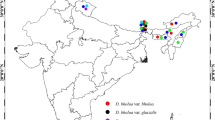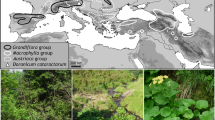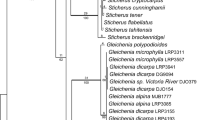Abstract
The genus Dyckia (Bromeliaceae) comprises more than 150 terrestrial or epilithic species with a strongly xeromorphic habit. Most of its members belong to the azonal rock vegetation of Neotropical savannas and forests of Brazil and adjacent countries. Dyckia is relatively species-rich compared with its closest relatives Encholirium (27 species) and Deuterocohnia (17 species). Here, we present the first molecular phylogenetic analysis of Dyckia using DNA sequence data from six plastid loci (matK gene, rps16 intron, petD intron, rpl32-trnL, rps16-trnK and trnD-trnT) and a portion of the nuclear gene phyC. A total of 124 accessions were included, corresponding to 79 taxa from six genera. Phylogenetic trees were generated using parsimony, likelihood and Bayesian methods. DNA sequence variation among Dyckia species turned out to be extremely low, and phylogenies were poorly resolved. The monophyly of Dyckia is supported, whereas evidence is provided that Encholirium is paraphyletic. Based on a dated plastid DNA tree, Dyckia experienced a recent radiation starting around 2.9 million years ago. Four major clades could be identified that roughly correspond to the geographic origin of the samples. A parsimony network based on plastid DNA haplotypes shows a star-like pattern, indicating recent range expansions. Our data are compatible with a scenario where Dyckia and Encholirium diverged in northeastern Brazil, whereas one lineage of Dyckia dispersed to southern Brazil from where a rapid colonization of suitable habitats was initiated. We discuss our results in relation to species delimitation in Dyckia.





Similar content being viewed by others
References
Antonelli A, Verola CF, Parisod C, Gustafsson ALS (2010) Climate cooling promoted the expansion and radiation of a threatened group of South American orchids (Epidendroideae: Laeliinae). Bot J Linn Soc 100:597–607
Baker JG (1889) Handbook of the Bromeliaceae. George Bell & Sons, London
Bänfer G, Moog U, Fiala B, Mohamed M, Weising K, Blattner FR (2006) A chloroplast genealogy of myrmecophytic Macaranga species (Euphorbiaceae) in Southeast Asia reveals hybridization, vicariance and long-distance dispersals. Mol Ecol 15:4409–4424
Barfuss MHJ (2012) Molecular studies in Bromeliaceae: implications of plastid and nuclear DNA markers for phylogeny, biogeography, and character evolution with emphasis on a new classification of Tillandsioideae. PhD Thesis, University of Vienna
Barfuss MHJ, Samuel R, Till W, Stuessy T (2005) Phylogenetic relationships in subfamily Tillandsioideae (Bromeliaceae) based on DNA sequence data from seven plastid regions. Amer J Bot 92:337–351
Barthlott W, Porembski S, Szarzynzki J, Mund P (1993) Phytogeography and vegetation of tropical inselbergs. In: Guillaumet J-L, Belin M, Puig H (eds) Phytogéographie tropicale. Réalités et perspectives. Colloques & Seminaires ORSTOM, Paris, pp 15–24
Benzing DH (2000) Bromeliaceae: profile of an adaptive radiation. Cambridge University Press, New York
Bernadello LM, Galetto L, Juliani HR (1991) Floral nectar, nectary structure and pollinators in some Argentinean Bromeliaceae. Ann Bot 67:401–411
Bjourson AJ, Cooper JE (1992) Band-stab PCR: a simple technique for the purification of individual PCR products. Nucleic Acids Res 20(17):4675
Caddah MK, Campos T, Zucchi MI, Pereira de Souza A, Bittrich V, do Amaral MCE (2013) Species boundaries inferred from microsatellite markers in the Kielmeyera coriacea complex (Calophyllaceae) and evidence of asymmetric hybridization. Plant Syst Evol 299:731–741
Clement M, Posada D, Crandall KA (2000) TCS: a computer program to estimate gene genealogies. Mol Ecol 9(10):1657–1660
Crayn DM, Terry RG, Smith JAC, Winter K (2000) Molecular systematic investigations in Pitcairnioideae (Bromeliaceae) as a basis for understanding the evolution of crassulacean acid metabolism (CAM). In: Wilson KL, Morrison DA (eds) Monocots: systematics and evolution. CSIRO, Melbourne, pp 569–579
Crayn DM, Winter K, Smith JAC (2004) Multiple origins of crassulacean acid metabolism and the epiphytic habit in the neotropical family Bromeliaceae. Proc Natl Acad Sci USA 101:3703–3708
Demesure B, Sodzi N, Petit RJ (1995) A set of universal primers for amplification of polymorphic noncoding regions of mitochondrial and chloroplast DNA in plants. Mol Ecol 4(1):129–131
Drummond AJ, Rambaut A (2007) BEAST: Bayesian evolutionary analysis by sampling trees. BMC Evol Biol 7:214
Ehlers TA, Poulsen CJ (2009) Influence of Andean uplift on climate and paleoaltimetry estimates. Earth Planet Sc Lett 281:238–248
Excoffier L, Foll M, Petit RJ (2009) Genetic consequences of range expansions. Annu Rev Ecol Evol Syst 40:481–501
Forzza RC (2005) Revisão taxonômica de Encholirium Mart. ex. Schult. & Schult. f. (Pitcairnioideae––Bromeliaceae). Bol Bot Univ São Paulo 23(1):1–49
Ghosh P, Garzione CN, Eiler JM (2006) Rapid uplift of the altiplano revealed through 13C–18O bonds in paleosol carbonates. Science 311:511–515
Givnish TJ, Millam KC, Berry PE, Sytsma KJ (2007) Phylogeny, adaptive radiation, and historical biogeography of Bromeliaceae inferred from ndhF sequence data. Aliso 23:3–26
Givnish TJ, Barfuss MHJ, Ee BV, Riina R, Schulte K, Horres R, Gonsiska PA, Jabaily RS, Crayn DM, Smith JAC, Winter K, Brown GK, Evans TM, Holst BK, Luther H, Till W, Zizka G, Berry PE, Sytsma KJ (2011) Phylogeny, adaptive radiation, and historical biogeography in Bromeliaceae: insights from an eight-locus plastid phylogeny. Am J Bot 98(5):872–895
Hmeljevski KV, Reis A, Montagna T, dos Reis MS (2011) Genetic diversity, genetic drift and mixed mating system in small subpopulations of Dyckia ibiramensis, a rare endemic bromeliad from Southern Brazil. Conserv Genet 12:761–769
Horres R, Zizka G, Kahl G, Weising K (2000) Molecular phylogenetics of Bromeliaceae: evidence from trnL (UAA) intron sequences of the chloroplast genome. Plant Biol 2:306–315
Huelsenbeck JP, Ronquist F (2001) MRBAYES: Bayesian inference of phylogenetic trees. Bioinformatics 17(8):754–755
Jabaily RS, Sytsma KJ (2010) Phylogenetics of Puya (Bromeliaceae): placement, major lineages, and evolution of Chilean species. Am J Bot 97(2):337–356
Jakob SS, Blattner FR (2006) A chloroplast genealogy of Hordeum (Poaceae): long-term persisting haplotypes, incomplete lineage sorting, regional extinction, and the consequences for phylogenetic inference. Mol Biol Evol 23(8):1602–1612
Krapp F (2013) Phylogenie und Evolution der Gattung Dyckia (Bromeliaceae). PhD thesis, University of Kassel
Leme EMC, Ribeiro OBC, Miranda ZJG (2012) New species of Dyckia (Bromeliaceae) from Brazil. Phytotaxa 67:9–37
Lisiecki LE, Raymo ME (2005) A Pliocene–Pleistocene stack of 57 globally distributed benthic d18O records. Paleoceanography 20:PA1003 (1–17)
Luther HE (2012) An alphabetical list of bromeliad binominals, 13th edn. Marie Selby Botanical Gardens, and The Bromeliad Society International
Martin CE (1994) Physiological ecology of the Bromeliaceae. Bot Rev 60:1–80
McKinnon GE, Vaillancourt RE, Jackson HD, Potts BM (2001) Chloroplast sharing in the Tasmanian eucalyptus. Evolution 55:703–711
Morjan CL, Rieseberg LH (2004) How species evolve collectively: implications of gene flow and selection for the spread of advantageous alleles. Mol Ecol 13:1341–1356
Müller J, Müller K, Quandt D (2011) PhyDE––Phylogenetic data editor. Version 0.9971. Program distributed by the author
Nylander JAA (2004) MrModeltest v2. Program distributed by the author. Evolutionary Biology Centre, Uppsala University
Oxelman B, Lidén M, Berglund D (1997) Chloroplast rps16 intron phylogeny of the tribe Sileneae (Caryophyllaceae). Plant Syst Evol 206:393–410
Palma-Silva C, Wendt T, Pinheiro F, Barbará T, Fay MF, Cozzolino S, Lexer C (2011) Sympatric bromeliad species (Pitcairnia spp.) facilitate tests of mechanisms involved in species cohesion and reproductive isolation in Neotropical inselbergs. Mol Ecol 20:3185–3201
Peters J (2009) Revision of the genus Fosterella L. B. Sm. Bromeliaceae. PhD thesis, University of Kassel
Rambaut A, Drummond AJ (2009) Tracer 1.5. Program distributed by the author
Rex M, Schulte K, Zizka G, Peters J, Vásquez R, Ibisch PL, Weising K (2009) Phylogenetic analysis of Fosterella L. B. Sm. (Pitcairnioideae, Bromeliaceae) based on four chloroplast DNA regions. Mol Phylogenet Evol 51:472–485
Santos-Silva F, Saraiva DP, Monteiro RF, Pita P, Mantovani A, Forzza RC (2013) Invasion of the South American dry diagonal: what can the leaf anatomy of Pitcairnioideae (Bromeliaceae) tell us about it? Flora 208:508–521
Sazima I, Vogen S, Sazima M (1989) Bat pollination of Encholirium glaziovii, a terrestrial bromeliad. Plant Syst Evol 168:167–179
Schulte K, Horres R, Zizka G (2005) Molecular phylogeny of Bromelioideae and its implications on biogeography and the evolution of CAM in the family (Poales, Bromeliaceae). Senckenb Biol 85:113–125
Schulte K, Barfuss MHJ, Zizka G (2009) Phylogeny of Bromelioideae (Bromeliaceae) inferred from nuclear and plastid DNA loci reveals the evolution of the tank habit within the subfamily. Mol Phylogenet Evol 51:327–339
Schütz N (2012) Systematics, morphology and taxonomy of the genus Deuterocohnia L. B. Sm. Bromeliaceae. PhD thesis, University of Kassel
Shaw J, Lickey EB, Schilling EE, Small RL (2007) Comparison of whole chloroplast genome sequences to choose noncoding regions for phylogenetic studies in angiosperms: the tortoise and the hare III. Am J Bot 94:275–288
Smith LB (1934) Geographical evidence on the lines of evolution in the Bromeliaceae. Bot Jahrbuch 66:446–468
Smith LB (1967) Notes on Bromeliaceae. Phytologia 14(8):457–491
Smith LB, Downs RJ (1974) Pitcairnioideae (Bromeliaceae). Fl Neotrop Monogr 14 Part 1:1–662
Stamatakis A (2006) RAxML-VI-HPC: maximum likelihood-based phylogenetic analyses with thousands of taxa and mixed models. Bioinformatics 22(21):2688–2690
Swofford DL (2003) PAUP*. Phylogenetic analysis using parsimony (*and other methods). Version 4.0 Beta 10. Sinauer Associations, Sunderland, Massachusetts
Tel-Zur N, Abbo S, Myslabodski D, Mizrahi Y (1999) Modified CTAB procedure for DNA isolation from epiphytic cacti of the genera Hylocereus and Selenicereus (Cactaceae). Plant Mol Biol Rep 17:249–254
Terry RG, Brown GK, Olmstead RG (1997) Examination of subfamilial phylogeny in Bromeliaceae using comparative sequencing of the plastid locus ndhF. Am J Bot 84:664–670
Versieux LM, Wendt T (2006) Checklist of Bromeliaceae of Minas Gerais, Brazil, with notes on taxonomy and endemism. Selbyana 27(2):107–146
Versieux LM, Wendt T (2007) Bromeliaceae diversity and conservation in Minas Gerais state. Brazil Biodivers Conserv 16:2989–3009
Versieux LM, Wendt T, Louzada RB, Wanderley MGL (2008) Bromeliaceae da Cadeia do Espinhaço. Megadiversidade 4:98–110
Vesprini JL, Galetto L, Bernadello G (2003) The beneficial effect of ants on the reproductive success of Dyckia floribunda (Bromeliaceae), an extrafloral nectary plant. Can J Bot 81:24–27
Watts CD, Fisher AE, Shrum CD, Newbold WL, Hansen S, Liu C, Kelchner SA (2008) The D4 set: primers that target highly variable intron loops in plant chloroplast genomes. Mol Ecol Resour 8:1344–1347
Winkler S (1980) Ursachen der Verbreitungsmuster einiger Bromeliaceae in Rio Grande do Sul (Südbrasilien). Flora 170:371–393
Winkler S (1986) Differenzierungen und deren Ursachen innerhalb der Bromeliaceen. Beitr Biol Pflanzen 61:283–314
Wöhrmann T, Pinangé D, Krapp F, Benko-Iseppon AM, Huettel B, Weising K (2013) Development of 15 nuclear microsatellite markers in the genus Dyckia (Pitcairnioideae; Bromeliaceae). Conservation Genet Resour 5:81–84
Wu C-I (2001) The genic view of the process of speciation. J Evol Biol 14:851–865
Wu C-I, Ting C-T (2004) Genes and speciation. Nat Rev Genet 5:114–122
Acknowledgments
The authors thank J. Peters, N. Schütz and the Botanical Gardens of Heidelberg, Bonn, Berlin-Dahlem, Marburg and Vienna for providing plant material as well as R.B. Louzada, G. Cruz and A. M. Wanderley for help during fieldwork. F. Krapp and D. Pinangé are supported by PhD fellowship grants of the Otto-Braun-Fonds (Melsungen) and the Fundação de Amparo à Ciência e Tecnologia do Estado de Pernambuco (FACEPE), respectively. This work was supported by DAAD (German Academic Exchange Service), by CAPES (Brazilian Coordination for the Improvement of Higher Education Personnel) in the frame of the PROBRAL and PNADB programs, an also by CNPq (Brazilian Counsel of Technological and Scientific Development).
Author information
Authors and Affiliations
Corresponding author
Rights and permissions
About this article
Cite this article
Krapp, F., de Barros Pinangé, D.S., Benko-Iseppon, A.M. et al. Phylogeny and evolution of Dyckia (Bromeliaceae) inferred from chloroplast and nuclear sequences. Plant Syst Evol 300, 1591–1614 (2014). https://doi.org/10.1007/s00606-014-0985-0
Received:
Accepted:
Published:
Issue Date:
DOI: https://doi.org/10.1007/s00606-014-0985-0




